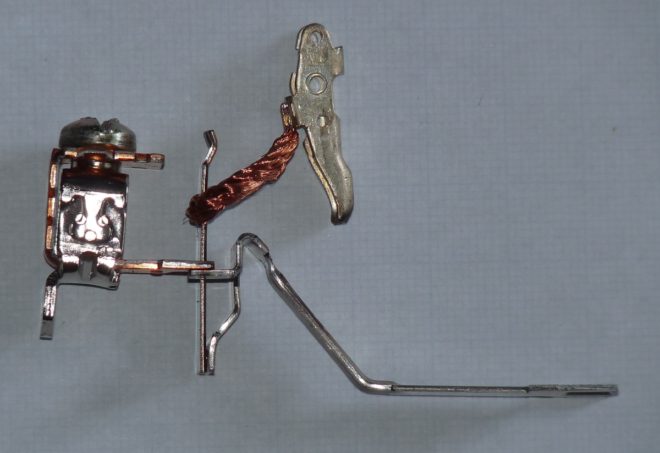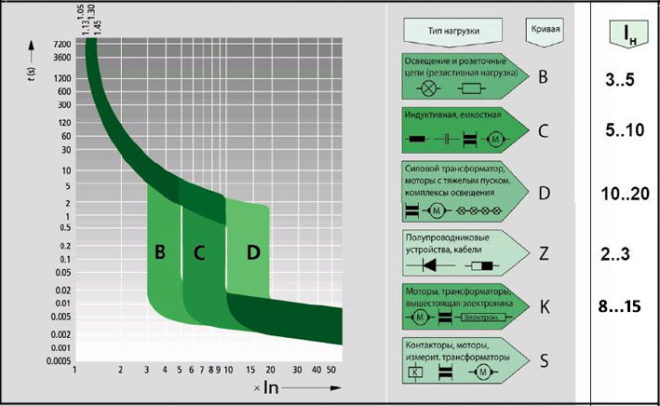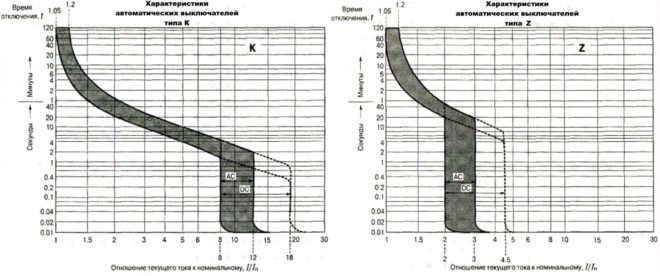Circuit breaker categories: A, B, C and D

Circuit breakers are devices that are responsible for protecting an electrical circuit from damage associated with exposure to a large current. Too strong a flow of electrons can damage household appliances, as well as cause overheating of the cable, followed by melting and ignition of the insulation. If the line is not de-energized in time, this can lead to a fire, Therefore, in accordance with the requirements of the PUE (Electrical Installation Rules), the operation of a network in which no electrical circuit breakers are installed is prohibited. AB have several parameters, one of which is the time-current characteristic of the automatic protective switch. In this article, we will tell you how category A, B, C, D circuit breakers differ and what networks they are used to protect.
Content
Features of the operation of circuit breakers
Whatever class the circuit breaker belongs to, its main task is always the same - to quickly detect the occurrence of excessive current, and to de-energize the network before the cable and devices connected to the line are damaged.

Currents that can pose a danger to the network are divided into two types:
- Overload currents. Their appearance most often occurs due to the inclusion of devices in the network, the total power of which exceeds that that the line can withstand. Another cause of overload is a malfunction of one or more devices.
- Overcurrents caused by short circuit. A short circuit occurs when the phase and neutral conductors are connected together. They are normally connected to the load separately.
The device and principle of operation of the circuit breaker - in the video:
Overload currents
Their value most often slightly exceeds the rating of the machine, therefore, the passage of such an electric current through the circuit, if it has not lasted too long, does not damage the line. In this regard, instantaneous de-energization is not required in this case; moreover, often the magnitude of the electron flux quickly returns to normal. Each AB is designed for a certain excess of the strength of the electric current at which it operates.
The tripping time of the protective circuit breaker depends on the magnitude of the overload: with a slight excess of the norm, it can take an hour or more, and with a significant excess - a few seconds.
A thermal release is responsible for turning off the power under the influence of a powerful load, the basis of which is a bimetallic plate.
This element heats up under the influence of a powerful current, becomes plastic, bends and triggers the machine.
Short-circuit currents
The flow of electrons caused by the short-circuit significantly exceeds the rating of the protection device, as a result of which the latter is immediately triggered, turning off the power. An electromagnetic release, which is a solenoid with a core, is responsible for detecting a short circuit and an immediate reaction of the device. The latter, under the influence of an overcurrent, instantly acts on the circuit breaker, causing it to trip. This process takes a split second.
However, there is one caveat. Sometimes the overload current can also be very large, but not caused by a short circuit. How is the apparatus supposed to distinguish between them?
In the video about the selectivity of circuit breakers:
Here we smoothly move on to the main issue that our material is devoted to. There are, as we have already said, several classes of AB, differing in time-current characteristics. The most common of these, which are used in household electrical networks, are devices of classes B, C and D. Circuit breakers belonging to category A are much less common. They are the most sensitive and are used to protect high-precision devices.
These devices differ from each other in instantaneous tripping current. Its value is determined by the multiplicity of the current passing through the circuit to the rating of the machine.
Tripping characteristics of protective circuit breakers
The class AB, determined by this parameter, is indicated by a Latin letter and is affixed to the body of the machine in front of the number corresponding to the rated current.
In accordance with the classification established by the PUE, circuit breakers are divided into several categories.
Automatic machines type MA
A distinctive feature of such devices is the absence of a thermal release in them. Devices of this class are installed in the connection circuits of electric motors and other powerful units.
Overload protection in such lines is provided by an overcurrent relay, the circuit breaker only protects the network from damage as a result of overcurrent short-circuit.
Class A devices
Automata type A, as mentioned, have the highest sensitivity. The thermal release in devices with time-current characteristic A most often trips when the current exceeds the nominal AB by 30%.
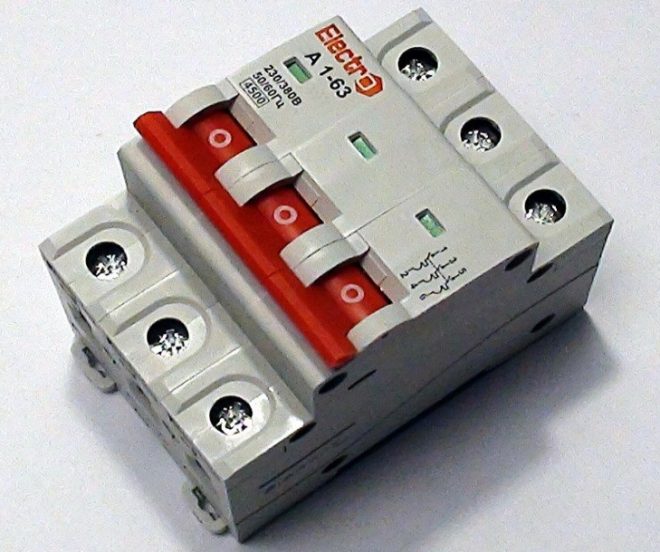
The electromagnetic tripping coil de-energizes the network for about 0.05 seconds if the electric current in the circuit exceeds the rated one by 100%. If, for any reason, after doubling the strength of the electron flux, the electromagnetic solenoid does not work, the bimetallic release cuts off the power for 20-30 seconds.
Automatic machines with time-current characteristic A are included in the lines, during the operation of which even short-term overloads are unacceptable. These include circuits with semiconductor elements included in them.
Class B protective devices
Devices of category B have less sensitivity than those of type A. The electromagnetic release in them trips when the rated current is exceeded by 200%, and the trip time is 0.015 sec. The actuation of the bimetallic plate in a breaker with characteristic B with a similar excess of the AB rating takes 4-5 seconds.
Equipment of this type is intended for installation in lines that include sockets, lighting devices and in other circuits where there is no starting increase in electric current or has a minimum value.
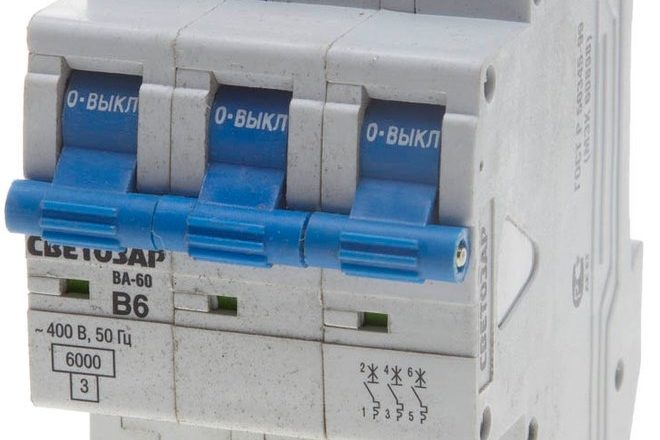
Category C machines
Type C devices are most common in home networks. Their overload capacity is even higher than those previously described. In order for the solenoid of electromagnetic release installed in such a device to operate, it is necessary that the flow of electrons passing through it exceed the nominal value by 5 times. The thermal release is triggered when the protection device is rated fivefold in 1.5 seconds.
The installation of circuit breakers with a time-current characteristic C, as we said, is usually carried out in household networks. They do an excellent job of acting as input devices to protect the general network, while category B devices are well suited for individual branches to which outlet groups and lighting fixtures are connected.
This will allow observing the selectivity of the circuit breakers (selectivity), and with a short circuit in one of the branches, the entire house will not be de-energized.
Category D circuit breakers
These devices have the highest overload capacity.For the operation of an electromagnetic coil installed in an apparatus of this type, it is necessary that the electric current rating of the circuit breaker is exceeded at least 10 times.
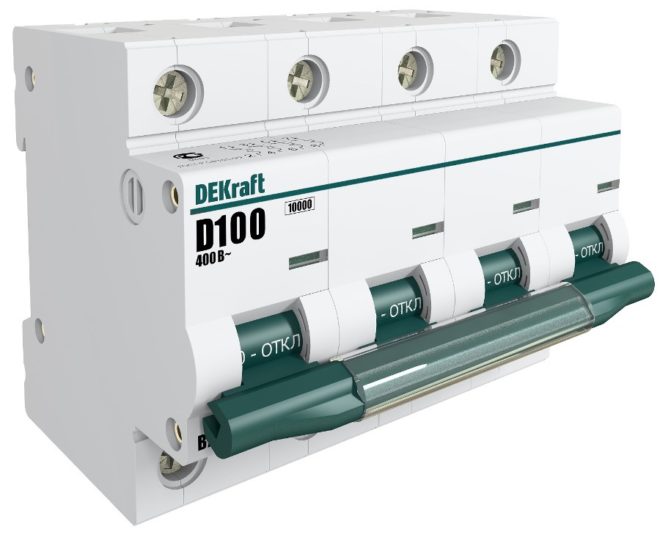
In this case, the thermal release is triggered after 0.4 seconds.
Devices with characteristic D are most often used in general networks of buildings and structures, where they play a safety role. They are triggered if there was no timely power outage by circuit breakers in separate rooms. They are also installed in circuits with large starting currents, to which, for example, electric motors are connected.
Category K and Z protective devices
Automata of these types are much less common than those described above. Type K devices have a wide variation in the values of current required for electromagnetic tripping. So, for an alternating current circuit, this indicator should exceed the nominal 12 times, and for a constant one - 18 times. The electromagnetic solenoid is triggered in no more than 0.02 seconds. The thermal release in such equipment can operate when the rated current is exceeded by only 5%.
These features are responsible for the use of type K devices in circuits with an exclusively inductive load.
Devices of type Z also have different operating currents of the electromagnetic release solenoid, but the spread is not as great as in AB category K. 4.5 times the nominal.
Devices with characteristic Z are used only in lines to which electronic devices are connected.
Visually about the categories of machines in the video:
Conclusion
In this article, we examined the time-current characteristics of protective circuit breakers, the classification of these devices in accordance with the PUE, and also figured out in which circuits devices of various categories are installed. This information will help you determine what protective equipment should be used on your network based on what devices are connected to it.

